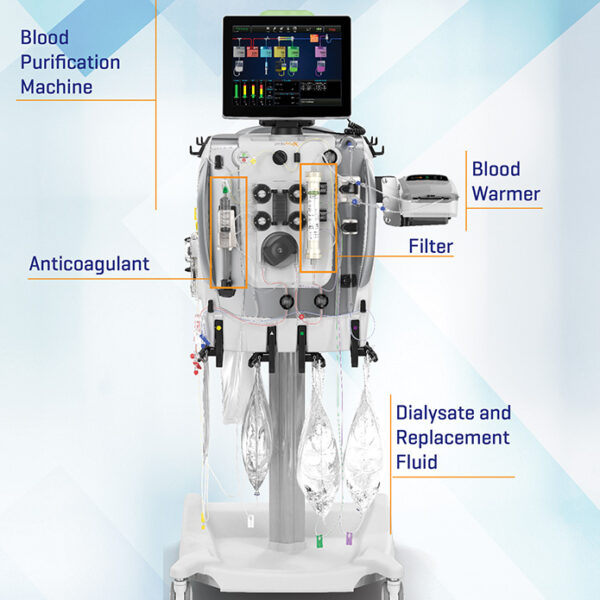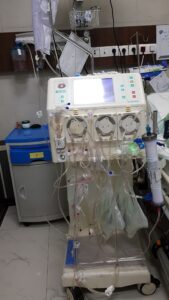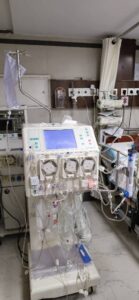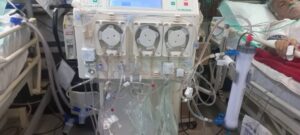CRRT services
Continuous renal replacement therapy (CRRT) is a special type of dialysis and is performed for unstable patients in the intensive care unit whose bodies cannot tolerate regular dialysis. This type of dialysis is very different from the regular type of dialysis that patients may be familiar with and requires special skills and expertise .
The most important strategic goals of Shafa Kala Yekta Medical Services Group are:
Providing desirable and quality services
Creating maximum satisfaction in covered patients
Using technology to improve patients’ quality of life
Special attention to patient assistance, counseling, and nutrition
Attention to in-service training of colleagues and necessary training for patients and companions
Cooperating with domestic and foreign research centers and defining practical projects to continuously improve the condition of patients.
Shafa Kala Yekta Company, aware of its responsibility and benefiting from the knowledge and experience of the top nephrology professors, and by formulating and supervising the implementation of treatment procedures in accordance with the latest scientific and research findings in this field, will play an important role in increasing qualitative and quantitative indicators and ensuring their continuity in the established centers.


CRRT is a slower type of dialysis that puts less strain on the heart . Instead of taking four hours, CRRT is done over a 24-hour period to slowly and continuously remove waste products and fluids from the patient’s body. A special anticoagulant is needed to prevent clotting in the dialysis circuit .
This treatment is primarily used in intensive care units for people with acute kidney failure. Known as hemofiltration, the blood is filtered through a special machine. The blood is then returned to the body along with replacement fluid .
The CRRT device is the most advanced device that can perform dialysis for patients of different age groups, even those under 15 years old, weighing more than 15 kilograms and with low blood pressure, without restrictions on patients with infectious diseases including HBV – HIV – HCV, with a completely closed, disposable and sterile system .
In general, the CRRT device mimics the function of the kidneys in regulating water and electrolytes and slowly and continuously removing toxic products from the blood without any side effects to the patient .
What is continuous renal replacement therapy (CRRT)? Continuous renal replacement therapy (CRRT) is a type of dialysis used to help people with kidney failure. When the kidneys are not working properly, CRRT can help remove waste products and excess fluid from the body. This type of dialysis is usually used for people with acute kidney injury (AKI) or end-stage chronic kidney disease (CKD). With regular dialysis, the rate at which waste products and fluids are removed from the patient is very rapid, potentially putting a strain on the patient’s heart and blood pressure. If the patient already has low or unstable blood pressure or heart problems, they will not tolerate regular dialysis. CRRT is a slower type of dialysis that puts less strain on the heart. Instead of taking four hours, this procedure is performed 24 hours a day to gently and continuously remove waste products and fluids from the patient’s body. How CRRT works CRRT works through a process called extracorporeal blood purification (ECBP). In this process, blood is removed from the body and passed through a filter or dialysis membrane. This filter removes waste products and excess fluids from the blood, and the cleaned blood is then returned to the body. CRRT can be done in different ways, including: Continuous venovenous hemofiltration (CVVH): This is the most common type of CRRT. In CVVH, blood is removed from the body through a venous catheter and then passed through a filter. Excess fluid is removed from the blood through a process called ultrafiltration. Continuous venous hemodialysis (CVVHD): This method is is removed from the blood through a process called ultrafiltration. Continuous venous hemodialysis (CVVHD): This method is similar to CVVH, but instead of using a filter, it uses a dialysis membrane to remove waste products from the blood. Continuous permeation and convection dialysis (SCUF): This method is a combination of CVVH and CVHD. In SCUF, the blood is passed through a filter and a dialysis membrane. Comparison table of types of dialysis methods at home Features of hemodialysis Peritoneal dialysis CRRT Location Hospital and home Home or hospital Hospital and ICU and home Process Blood is removed from the body and passed through a filter or membrane Dialysis fluids are injected into the abdominal cavity Blood is continuously removed from the body and passed through a filter or membrane Frequency 3 times a week, for several hours 4 times a day Continuously Advantages Effective for removing waste products and excess fluids Can be done at home Suitable for people with severe kidney failure who need urgent or continuous dialysis Disadvantages Requires a hospital visit Can be cumbersome and increases the risk of infection Requires specialized care Advantages of CRRT dialysis • Greater stability: CRRT continuously purifies the blood, which can help to keep fluids and electrolytes in the body more stable. This can be beneficial for patients who have unstable blood pressure or are sensitive to rapid changes in fluids and electrolytes. • Gentler fluid removal: CRRT removes fluids slowly and continuously from the body, which can reduce the risk of hypotension and other side effects. • Greater flexibility: CRRT can be used for a wider range of patients, including infants and children, as well as patients with heart or lung failure.Side Effects of CRRT • Anytime there is a catheter in the body, there is a risk of infection. • CRRT can increase the risk of bleeding, especially in patients with clotting disorders. • It can cause low blood pressure, especially in patients with anemia. • It can cause electrolyte imbalances in the body. In general, the choice of dialysis type depends on each patient’s specific condition and the doctor’s opinion.





